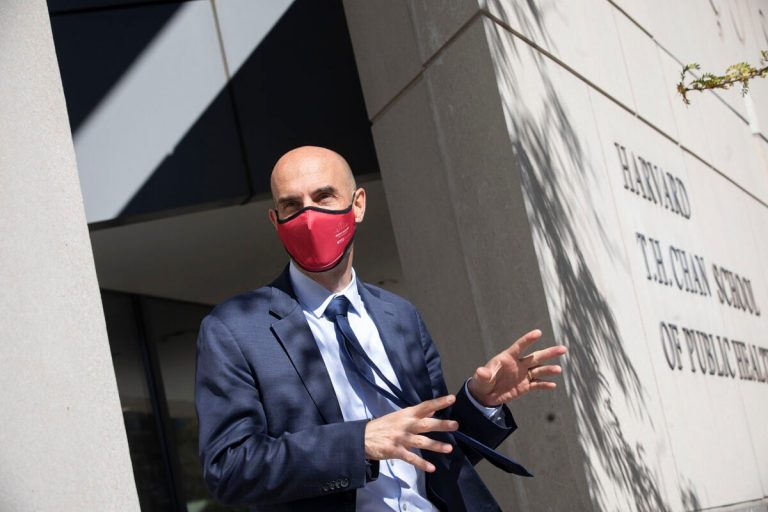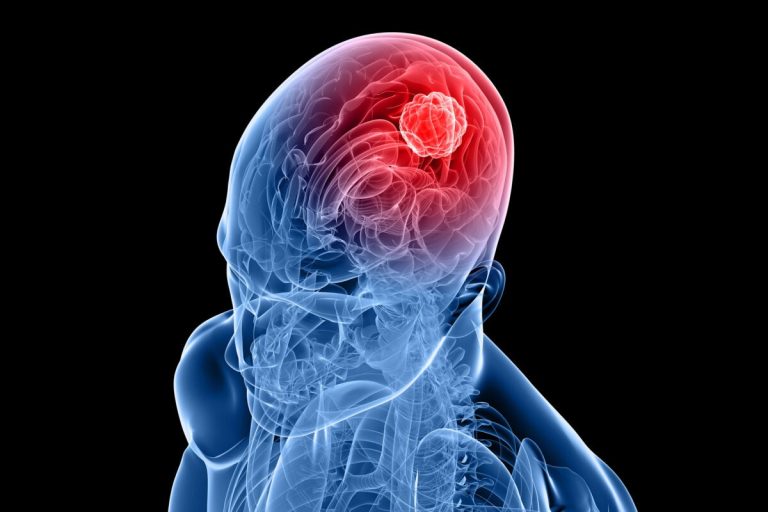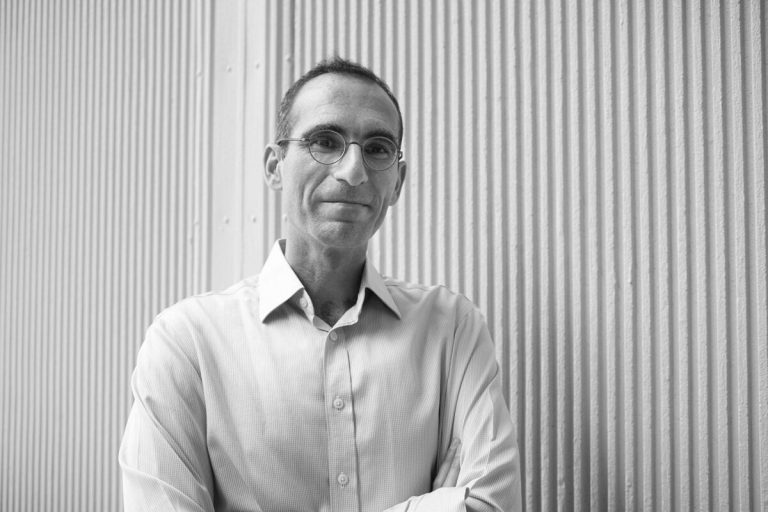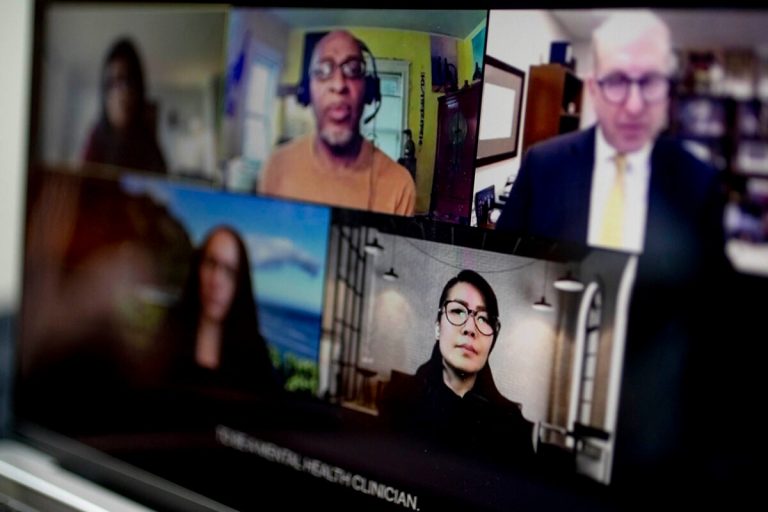Joseph Allen shakes his head over the fact that so many of the nation’s K-12 students are still attending some or all of their classes online due to COVID concerns. Allen, a Harvard T.H. Chan School of Public Health associate professor of exposure science who runs the School’s Healthy Buildings Program, argued early on that last spring’s pivot to online learning showed the many ways in-person education is superior to online and that there are concrete, practical ways to manage health risks. But, he says, we’ve failed schoolchildren by letting community transmission remain so high that people are hesitant to reopen schools fully. Even then, he says, there are many communities that could bring kids back to school that aren’t doing so, with potentially devastating consequences to learning, socialization, nutrition, and other aspects of growing up fostered by the school environment. Allen shared his thoughts with the Gazette.
Q&A
Joseph Allen
GAZETTE: We’re over a month into the reopening of schools and there have been outbreaks reported in many places, student parties causing concern, educational strategies switching from in-person to remote, and even Massachusetts’ governor urging communities with low transmission to switch to in-person learning. How do you think we are handling the return to school?
ALLEN: We are failing. Kids out of school — and I’m talking about K-12 schools — is a national emergency, and it is not being treated as such. The conversation on schools has gotten very reductionist in terms of in-classroom risk. That risk is important, but it actually can be managed and very few are talking about the risks of kids being out of school.
The consequences are devastating. We have virtual dropouts. We have major school districts in the U.S. where a third of the kids are not logging in every day. This spring, right here in Boston, 10,000 high school kids didn’t log in at all in the month of May. Kids are less social, and the learning is different. According to UNICEF, kids in school are less likely to suffer from abuse, neglect, exploitation, and violence. Over 30 million kids rely on schools for nutrition, so there are food-security issues. There’s a risk from COVID, but that can be managed in the classroom.
That’s why I think we are failing. It’s not like it was a surprise that kids were going to go back to school in September. The second we closed schools in March, it should have been an urgent and national priority to figure out a plan for how to get them back. Instead, we opened things like bars, restaurants, and casinos, and now we have millions of kids who are not in school. We have kids who are totally unaccounted for.
GAZETTE: So you believe that people are focused solely on the risk from COVID and ignoring the countervailing risk of kids losing education, with the associated harms?
ALLEN: I’m not minimizing the risk from COVID, but it’s the reality that we know how to control risk in schools. If we put in measures like universal masking, better ventilation — which can mean opening up the windows, using portable air cleaners with HEPA [High Efficiency Particulate Air] filters — we know this can reduce risk. Schools also benefit in that the risk profile of kids is much different than [that of] adults. This virus hasn’t spared us in many ways, but in one, it has given us a break, and that is that kids are less likely to get this than adults. They’re much less likely to suffer severe consequences if they do get it, and there’s good evidence that suggests they transmit it less than adults. Risk is context-dependent, and we have to include those facts in our decision-making. There are devastating consequences from kids being out of school. This is a national emergency. That’s not overstating it.
GAZETTE: You made a suite of recommendations about how to safely reopen schools in a report at the beginning of the summer. Are there particular recommendations that are not being taken?
ALLEN: We’ve worked with many schools and school districts and superintendents and teachers, and the schools we talked with are implementing, and I’ve heard stories from other schools that are taking our approach. What has been a challenge is that I hear things like, “Well, we can’t do that, we’re in an old building. Our systems are old.” The reality is there’s always something you can do. We presented almost step-by-step guides for how it can be done. If your ventilation system is older, can you pop open windows? Even just a couple of inches will give you four or five, six air changes per hour. In your unit ventilators, can you change the damper position so you bring in a bit more outdoor air? Can you upgrade to better filters so that it does a better job of filtering out any viral particles in the recirculated air? Some might say, “I’m in a classroom that’s interior and doesn’t have windows.” Well, you can use a portable air cleaner with a HEPA filter and get four or five, six air changes per hour using this relatively inexpensive tool.
GAZETTE: Do you need special air cleaners designed to filter out viruses or is a HEPA filter good enough?
ALLEN: I’ve been really careful to not recommend things that are going to cost a million dollars and take months to install. The portable air cleaners with the HEPA filters are tried-and-true technology. The science on how they work is really clear and decades deep. And it’s literally as simple as plugging one into the wall and turning it on. The filter captures 99.97 percent of particles at 0.3 microns. These filters are going to capture any airborne viral particles. So there’s always something you could do.
We proposed this as a national strategy: Think about the billions we’re giving away in stimulus. How about a portable air cleaner in every classroom? It is a really cheap, inexpensive way to get our students back and keep risk low. This is a strategy that can work through the depths of winter in the Northeast, for example, when you can’t open your windows.
We heard pushback that opening windows wasn’t a good strategy, so we went out in schools and showed that just opening windows a couple of inches and having a door open for the cross breeze can bring in a lot of fresh outdoor air. We wrote a five-step guide for how to assess classroom ventilation, and we pushed it out to everybody on our page. We built an online tool, a simple calculator, that you put in the dimensions of your classroom and [it] helps you pick a portable air cleaner that will be effective. We tried to simplify this and ensure that all solutions are grounded in evidence-based risk-reduction measures that we know can drive down risk in schools and help get kids back in.
GAZETTE: If you were to do your June guidelines over again now, knowing what you know now, knowing what people may be reluctant to do, would you offer a different way forward?
ALLEN: I don’t think there’s anything we would change because the recommendations were grounded in the science on how we’re exposed and what control strategies work. Over the past couple of months that hasn’t changed. We’ve been clear on the need for universal masking — all the risk models say masks work, and they drive down risk. Disparities are widening for Black and brown communities. They’re widening for women, who are having to choose between work and their kids. A disproportionate burden of home life and homeschooling is falling on women.
GAZETTE: Is it reasonable to expect us to get better with experience? And is there a particular area that you would recommend we focus on to get better?
ALLEN: I think we’re going to get better. Medicine has gotten better. The medical communities have driven down risks to themselves when people get sick and come in. We’re learning each and every day. We’ve been in warmer weather and have gotten the benefit from time outdoors and indoors with windows open. Kids, when they socialize out of school, it’s at the park; it’s at the playground; it’s on a field. But as it gets colder, everybody moves indoors. My concern is that schools that haven’t put in these rigorous strategies or haven’t paid attention to things like ventilation and filtration could have a problem. If you look at all the outbreak data, they all have a couple of things in common: no masking, low to no ventilation, and time indoors. So, as we move into the winter, if schools don’t have kids in masks and they have not paid attention to ventilation and filtration, that leads to higher risk. For schools whose students have their masks on, and that have put in the controls, and are meeting air-exchange targets — either through ventilation or filtration — that gives me a lot more confidence. I should also say that what is key here — and we said this early on — is that we have to make sure community spread is low. If community spread is low, any one person is less likely to have it. If it’s a kid going into school, schoolkids are less likely to get it; they’re less likely to transmit it, and less likely to die from it. So we have to drive down community transmission and prioritize school reopening over other aspects of the economy: opening bars and restaurants and casinos.
GAZETTE: So if we have to sacrifice, school should be the priority?
ALLEN: What’s our job in this country? It’s to educate and care for the next generation. Also the economy doesn’t restart when kids and parents are home. And, when they’re both home, you don’t quite have people working, and you don’t quite have kids learning.
GAZETTE: How do we know if community transmission is low enough? Here in Massachusetts, we’ve had an uptick in cases in recent weeks. Are the state guidelines — which say towns in the red level of transmission shouldn’t open in person — in concert with your own feelings to open as soon as you can?
ALLEN: I think that Massachusetts is doing a really nice job. And I also largely agree with the metrics that are in place. When community spread is low, kids should be back in school. There’s a lot of agreement between the public health community, epidemiologists, building scientists, engineers, and educators on the importance of getting kids back to school and on what controls need to be in place.
When the metrics are met, as they have been in Massachusetts, but schools in some districts stay closed, I think that’s a problem. If they don’t open when community spread is low and the weather has been perfect for the past two months and school and the buildings are ready, when will they open? In some ways, I feel like we squandered the two nicest months of the year for learning. It has been a time when all the windows could definitely be open, where classes can be held outside or on a walk or on a ball field. I think schools that have stayed closed have made a mistake.
GAZETTE: Can the current school setup — current practices — withstand a fall/winter surge? Or do you see it forcing us to take steps back?
ALLEN: It depends on what we prioritize as a society. Even if there was a surge, if we closed other aspects of the economy, I think we could keep schools open. But I don’t have a lot of confidence that would happen. I don’t know if there’s the will to do that.
GAZETTE: Is in-person learning coast-to-coast a realistic goal?
ALLEN: It’s not just a realistic goal, it has to be the goal. If we start with a goal that’s anything short of that, then then we’re not doing what’s needed, which is prioritizing schools. So it absolutely should be the goal. I think the president should be talking about this every day. I think everyone should be talking about this every day. I don’t think I’m exaggerating or overstating the case. Right now, occasionally we’ll see a case of COVID in a school that will make headlines. But you can predict the headlines we’re going to see in the coming months and years about kids who disappeared from the system, the virtual dropouts, the loss of learning, the loss of income, which we know happens when kids are left behind with schooling. The public health headlines in the coming years because schools are closed are entirely predictable, and they’re avoidable if we get our act together and prioritize reopening schools.
GAZETTE: What about success stories? We hear about spikes. We hear about kids being lost. We don’t hear about schools that have successfully reopened and it’s mainly been OK. Are there examples out there? Are there a lot of examples out there?
ALLEN: There are a lot of examples out there. In academia, we talk about publication bias, that a null finding is not that exciting; it doesn’t make the news, doesn’t catch anybody’s attention. But there were YMCAs open in New York City right through the peak of this in March and April and had no problems. There are many camps that were open this summer across the U.S. with no problems. I’ve worked with childcare centers in under-resourced communities that had to stay open through the spring because they care for the children of essential workers. No issues.
The denominator is important here. We have a school with cases, and that’s important because we need to learn from that. We need to know what went wrong and why that’s happening. But if the denominator is massive — the number of places that aren’t having a problem — we need to learn from those, too. Why aren’t cases happening there? Is it about controls? Is it dumb luck? Is it about low community spread?
GAZETTE: Do you have any final thoughts about what people should think about as we move into the colder weather?
ALLEN: Use this time while the weather is mild to prepare for the depths of winter.










